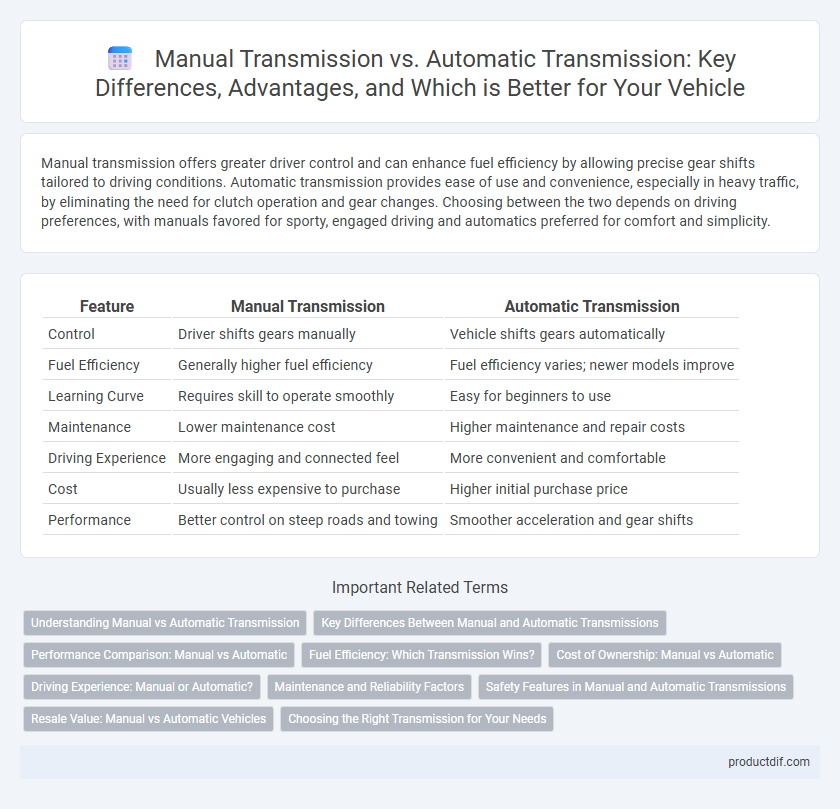Manual transmission offers greater driver control and can enhance fuel efficiency by allowing precise gear shifts tailored to driving conditions. Automatic transmission provides ease of use and convenience, especially in heavy traffic, by eliminating the need for clutch operation and gear changes. Choosing between the two depends on driving preferences, with manuals favored for sporty, engaged driving and automatics preferred for comfort and simplicity.
Table of Comparison
| Feature | Manual Transmission | Automatic Transmission |
|---|---|---|
| Control | Driver shifts gears manually | Vehicle shifts gears automatically |
| Fuel Efficiency | Generally higher fuel efficiency | Fuel efficiency varies; newer models improve |
| Learning Curve | Requires skill to operate smoothly | Easy for beginners to use |
| Maintenance | Lower maintenance cost | Higher maintenance and repair costs |
| Driving Experience | More engaging and connected feel | More convenient and comfortable |
| Cost | Usually less expensive to purchase | Higher initial purchase price |
| Performance | Better control on steep roads and towing | Smoother acceleration and gear shifts |
Understanding Manual vs Automatic Transmission
Manual transmission offers direct control over gear changes, enhancing driving precision and fuel efficiency, especially in performance vehicles. Automatic transmission provides seamless gear shifts through a torque converter or dual-clutch system, prioritizing convenience and ease of use in urban and stop-and-go traffic. Understanding the mechanical differences helps drivers choose based on driving style, vehicle type, and fuel consumption preferences.
Key Differences Between Manual and Automatic Transmissions
Manual transmissions require the driver to manually shift gears using a clutch pedal and gear stick, offering greater control over engine power and fuel efficiency. Automatic transmissions use a torque converter and planetary gear sets to shift gears seamlessly without driver input, providing ease of use and reduced driver fatigue. Key differences include driver engagement, maintenance complexity, fuel consumption, and overall driving experience.
Performance Comparison: Manual vs Automatic
Manual transmissions offer superior control over gear selection, enabling drivers to optimize engine performance and fuel efficiency, especially in sporty or demanding driving conditions. Automatic transmissions provide smoother shifts and ease of use, improving comfort and reducing driver fatigue, but may exhibit slight delays in power delivery compared to manuals. Modern dual-clutch automatic systems narrow the performance gap by delivering faster shift times and improved acceleration, challenging the traditional dominance of manual gearboxes in high-performance vehicles.
Fuel Efficiency: Which Transmission Wins?
Manual transmissions often provide better fuel efficiency by allowing drivers to control gear shifts and optimize engine performance, especially in city driving and varying terrains. Automatic transmissions have improved significantly with technologies like CVTs and dual-clutch systems, narrowing the fuel economy gap in modern vehicles. However, manual gearboxes typically remain more fuel-efficient in comparable models due to mechanical simplicity and reduced parasitic losses.
Cost of Ownership: Manual vs Automatic
Manual transmissions generally have a lower initial purchase price and reduced maintenance costs, leading to decreased overall cost of ownership compared to automatic transmissions. Automatic transmissions, with advanced technology like CVT or dual-clutch systems, often incur higher repair expenses and more frequent fluid changes. Resale values for vehicles with manual transmissions may be lower due to decreased market demand, but the long-term savings on fuel and maintenance can offset this difference.
Driving Experience: Manual or Automatic?
Manual transmission offers drivers precise control over gear changes, enhancing engagement and connection with the vehicle, ideal for those who enjoy a hands-on driving experience. Automatic transmission provides smooth, effortless shifting, reducing driver fatigue and allowing focus on road conditions, suitable for urban driving and stop-and-go traffic. Choosing between manual and automatic transmissions depends on personal preference for driving dynamics and convenience in different environments.
Maintenance and Reliability Factors
Manual transmissions generally require less complex maintenance due to fewer moving parts, with routine tasks including clutch replacement and fluid changes typically extending beyond 50,000 miles. Automatic transmissions involve more intricate components like torque converters and planetary gears, necessitating regular fluid checks and replacements every 30,000 to 60,000 miles to maintain optimal performance and avoid costly repairs. Reliability for manuals is often higher in rugged conditions where precise control is needed, whereas automatics offer consistent ease of use but may incur higher long-term maintenance costs due to their mechanical complexity.
Safety Features in Manual and Automatic Transmissions
Manual transmissions allow for greater driver control during unexpected road conditions, which can enhance safety by enabling precise gear selection and engine braking. Automatic transmissions incorporate advanced safety features like hill-start assist and adaptive cruise control integration, reducing driver fatigue and improving response times in traffic. Both transmission types contribute to vehicle safety but leverage different mechanisms to optimize driver control and assistance.
Resale Value: Manual vs Automatic Vehicles
Manual transmission vehicles often retain higher resale value due to their appeal among driving enthusiasts and lower maintenance costs. Automatic transmission cars tend to have broader market demand, which can stabilize resale prices but may depreciate faster in markets where manuals are prized. Regional preferences and vehicle type significantly influence the resale value difference between manual and automatic transmissions.
Choosing the Right Transmission for Your Needs
Selecting the right transmission depends on driving style, terrain, and maintenance preferences. Manual transmissions offer greater control and fuel efficiency, ideal for enthusiasts and challenging roads, while automatic transmissions provide ease of use and smoother shifting, perfect for urban commuting and heavy traffic. Understanding these benefits ensures a transmission choice that enhances comfort, performance, and long-term vehicle value.
Manual Transmission vs Automatic Transmission Infographic

 productdif.com
productdif.com